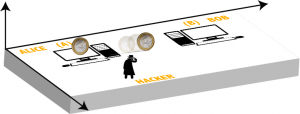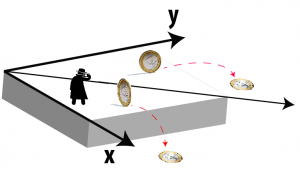The day I thought of her, she also thought of me.
Why does love work like this? Why, even far away, both can still feel?
Is love a quantum effect?
Maybe it is quantum entanglement…
On a winter day I arrived in Prague. I did not have a specific plan, except to wait for the next day and take the flight to Moscow.
What is the probability that you meet someone in a remote place? In a place you did not even think to be…? Zero? Many will say yes…! After many months I saw her in the city where Hitler had planned to die, did you know? Hitler never destroyed Prague, he loved it and wanted to keep it as his last home. In that same city, on a winter day I saw her again, I understood then that events, as impossible as they may seem, can exist. True! That’s what quantum physics is about…
If I saw her it was thanks to the information flux, to that parameter that constantly moves around the world and we often forget that it is there.
It was in the 70s that a young student built Microsoft imagining a world where everyone had their own information. He succeeded! But over the years he was wrong. When the Internet emerged people sought to disseminate the information, they did it on a large scale and only two guys realized that this information should be efficiently selected. Google did it in the 90s, but over the years they were also wrong. People not only disseminated the information, they sought to interact because in the end we like to socialize. A student saw an opportunity here and consolidated a social network in 2003; however, Facebook was also wrong. The world evolved and the cell phone became the favorite toy, nonetheless people of that time did not see there a great use, except one that with his friends launched in 2009 an instant messaging application called WhatsApp. There is no secret in saying that in few years WhatsApp will also be wrong. What will come? Maybe you already have the answer. Yes…! It is hidden in the information flux. Microsoft stored it, Google ranked it, Facebook shared it, and WhatsApp, among other applications, decentralized it…
Eventually, it was a WhatsApp message that made me see her again. I was in transit to Moscow, I did not know what I was going to do.
“Hello, are you in Prague…? I was notified that you are there.”
The message appeared on the screen of my cell phone. It was her! We said goodbye 6 months ago at Rosenheimer Str., in front of the Bürgerbräukeller where Hitler started his revolution. I went to Peru and never heard from her again. So, how could she has been notified? The only thing I did when I arrived in Prague was to access Airbnb and check a couple of apartments. They never responded. With the hours I understood they actually did. I had registered a year ago with her number and I never changed it, that’s why she was contacted instead. I had forgotten this detail, like many others we keep forgetting on the web… But what is interesting is that the same day without knowing the reasons behind, she was also arriving in Prague.
“Come with me tomorrow, I’m going to Avast,” she told me that evening while sharing a Trdelník in the old town. She had arrived for a work event. I had to choose between going to Moscow or staying for Avast.

If in the 70s Bill Gates founded Microsoft and in the 90s Larry Page and Sergey Brin founded Google, what happened in the 80s? Prague has the answer, two Czechs created Avast. In the rudimentary computers of that time they programmed an antivirus without knowing that this would turn them into the founders of a cyber security company. When I visited the facilities I thought about it: “If Microsoft stored it… Avast secured it.” However, I cannot say that Avast was wrong over time, on the contrary, cyber security is now one of the most important issues in the information flux. The ransomwares, trojans, spywares, spams, worms, bots, are just some names that hackers use to alter or steal the digital information. The funny thing is that these names are increasing over time because everything is migrating to the web, with saying that today the most relevant attacks are those focused on mining cryptocurrencies. Yes! Even coins are migrating to the web. But here is where all starts because the world already speaks of an IoT time…

The internet of things (IoT) is what will come. All devices, from a toaster to a fan, will be connected through the internet, information will be present everywhere around the world, this implies more hackers and therefore greater needs for cyber security help. Avast won the lottery, indeed, like Kaspersky, McAfee, Norton, and many others. Because if today’s cyber-attacks are huge, what can we expect from an IoT time? In the adjacent image I show a map where each line represents a cyber-attack in real time. I took it at Avast, in its main room. But as every company is meant to fail over time, it is feasible to assume that Avast will also do so. “In which way?” I questioned myself as I left the building at 4pm. I found the answer just arriving at Pankrác station. Inadvertently, two coins fell on the floor when I grabbed my wallet from my pocket, when I looked at them, one landed heads up (H), the other tails (T), then I thought: How many times can this happen? The options are only four, both may land heads up (HH), or tails (TT), or both may land with opposite values (HT or TH), so the probability is 2/4 = 0.5. What would happen if it would be 1? That is, what would happen if we achieve to have both coins always landing with opposite values? Although it may sound strange… Avast would cease to exist, but even stranger is to know that we can achieve this.
For this let’s imagine a two-dimensional world, a fictional world where everything moves on the plane. Let’s draw on it two computers spaced one from another and place the two coins in one of them. Because we are on the plane it is obvious that these coins can only take one value. Let’s consider that one coin is heads and the other is tails. Does it look familiar? They just represent the information bits: 1 (heads) and 0 (tails). Imagine that Alice (A) wants to send information to Bob (B), for this she will use her computer. For simplicity she sends one of the coins. Remember that it is a two-dimensional system, therefore the coin must travel along the plane until it reaches B. At an intermediate point it is feasible to assume that someone can steal this coin (the information). For this you can imagine leaving the bank with a certain amount of money and going back home. The same thing happens, somewhere in between someone may steal your money. These thieves in the digital world are called hackers and to avoid the assault it is convenient to have cyber security softwares installed in your machine, which behave as police stations in the city. In figure 3 we represent this scenario.

Suppose now that the hacker is not present in the information transfer. In this case, Bob will receive the coin without any perturbation and only Alice and him will know the information given. As a matter of fact, when Bob checks the value of his coin, he will immediately deduce the coin that Alice has in her possession. Why? Because we are only using two coins with opposite values. We say in this case that these are two correlated coins since it is enough to know the value of one of them to deduce the value of the other. This is how information works nowadays, It looks quite primitive, doesn’t it…? Indeed! But why can we assume that Avast would cease to exist if we manage to obtain always coins with opposite values when they are thrown to the ground? The answer lies in quantum physics, in a concept called Quantum Entanglement.
In a previous article where I spoke about the theory of probability, I outlined my desire to write about Quantum Entanglement; however, I did not know how to do it until that strange day in Prague that I took her hands and understood that despite the distance there was a transparent and instantaneous bond that kept us together… Right! Just like quantum physics! In fact, Quantum Entanglement behaves like this. To understand it, consider again the two coins. If we can associate the classical world of information with a two-dimensional system, then the quantum world will be associated with a three-dimensional system, remember that it is a more abstract world; in it, the coins can be placed on a plane in vertical position, see Figure 4. Being like this, they can take the two values, heads and tails on each side. Keep in mind that now we are talking about quantum coins. While in the classical world each coin could only take one value, in the quantum world both take the two values; because of this we usually speak of quantum-bits or rather “qubits.” This is the reason why quantum physics is very abstract, quantum systems are governed by the theory of probability, because all values are possible and to be able to determine only one we would have to make a measurement; in the case of the coins, let’s say, we would have to throw them to the ground and see what values they take. Only in this way we can define a state that can be understood by the human eye. But that’s not all, Quantum Entanglement goes further and tells us that if we make this measurement with two coins of the same quantum origin, it is enough to observe the value that one coin adopts, to know that the other one will have the opposite value, regardless if they are far away, as if there were a transparent and instantaneous bond that keep them together. You could bet a million dollars on this and you would not lose. While in the classical world your chances of obtaining two coins with opposite values is 2/4 = 0.5, in the quantum world it is 1. How does this influence the information?

Let’s return to Alice and Bob’s computers. In this case computer A stores two coins subject to the laws of Quantum Entanglement. They have not yet been measured and therefore their values are not defined, that is, they are placed in a vertical position on a plane. Alice wants to give Bob some information. She has no choice but to send one of the coins. At an intermediate point the hacker may steal this information, but there is no such information because the coin is rolling on the plane with the two values given, see Figure 4. In the classical world we saw that the coin that traveled from A to B was already defined, then for the hacker it was easy to know the value of the coin. In the quantum case he cannot determine it, the only thing he has left is to dare himself to define it, that is, to throw it on the ground and see the value it gets. Let’s say that he does it and it lands heads up. Being subject to the laws of the Quantum Entanglement, Alice’s coin will necessarily lands tails when she makes her measurement. As you can see, until this point the hacker is the only one who knows the values of the coins, but these values are not valid until Alice does not give them a meaning. For example, Alice could call Bob using a conventional telephone and tell him that if he gets heads it means “YES” as information and if he gets tails it means “NO”. But to do so Alice must be sure first that nobody has altered the information. She will make her measurement and as expected, she will obtain tails. The hacker in turn will seek to go unnoticed, he will send Bob the coin he measured, but this time the coin will travel on the plane as in the two-dimensional case because it has already been defined before, so when Bob makes his measurement he will necessarily get heads. The hacker has triumphed in this instance, he has not been detected and knows the values of the coins. However, you must remember that the quantum world is very abstract. Quantum Entanglement presents a certain peculiarity. For two particles to show opposite values they must be measured in the same direction. For example, in the case of electrons, the measurement of intrinsic angular momentum along the x, y, or z axes is considered, which can take only two values: spin-up or spin-down. Here we will use the coins to facilitate the understanding, where heads and tails values can be associated with the spin-up and spin-down values of electrons.
In fact, the example given above is not totally true, the fact that the hacker measures heads does not necessarily imply that Alice will get tails, this will only happen if both measured the coins in the same direction. We can think in this case that “the same direction” is given by throwing them along the same axis, see Figure 5.

Let’s see how this affects the transfer of information. Initially we said that the hacker gets heads doing the measurement, now we will specify that he made it along the x-axis. The above example is correct only if Bob and Alice choose the same axis as the hacker, but they will have the freedom to choose the axis they want. This is a random decision. Whether the axes coincide or not is a matter of luck. Let’s say that Alice chooses another direction, then her coin has a chance to be heads too. Only along the x-axis we would be convinced that Alice would get tails. As you can see, due to this peculiarity, the hacker cannot decipher the value of the coin that Alice has. When she makes her measurement, you should also note that at that moment both coins have been measured, this implies that the system has collapsed (from the three dimensional world to the two-dimensional world) and therefore Quantum Entanglement is no longer valid, that is, any subsequent measurement made in one coin will not have any influence in the other. The hacker, seeking to be unnoticed, will send the coin he measured to Bob, he will do it classically (the two-dimensional case) because it is already a defined coin. If Bob chooses the x-axis in his measurement (the hacker’s axis), the result will not change, he will get heads; however, if he chooses another axis, the coin has a chance to be heads or to be tails, that’s why quantum physics is always regarded as strange… Now let’s assume that Bob randomly chooses the same axis that Alice used, and what is worse for the hacker, let’s consider that he gets heads as a result (the same value Alice gets). At this point, the hacker does not know the value of the coins, his efforts to steal the information have failed. Alice will call Bob on the phone and ask him for the axis of his measurement and the value he obtained. With this, she will discover that there is someone who has altered the result because if they have used the same axis Bob should have gotten tails. As you can notice in this analysis, with some luck the hacker can still go unnoticed, but this luck only exists because we have used two coins, imagine that we take more than 100 pairs of coins, all subject to Quantum Entanglement. The hacker cannot be that lucky, otherwise he should be playing the lottery every week. The outcome is just one. The hacker would lose relevance… and therefore companies like Avast would cease to exist.
Now let’s consider the case in which the hacker decides not to touch the information. Alice will do the respective tests to conclude that there are no intruders in the intermediate points. From there, she will formulate the true information she wants to convey to Bob. For example, she will use two coins subject to Quantum Entanglement, one she will measure it on the x axis and the other she will send it to Bob. Bob is free to choose the axis he wants. For simplicity let’s assume that Bob chooses the same axis, if not, the experience is repeated until the match is found. Alice calls Bob and asks him about the axis he used in his measurement. That information is enough for Alice to deduce the value of the coin he has. If Alice got tails, Bob will necessarily get heads, then she will say: “Bob, if you measured heads means YES, if you measured tails means NO.” She won’t mind if someone steals this other information, because only she and Bob know what coins they have. This is a simple way to understand quantum encryption based on Quantum Entanglement. A deeper explanation making use of the intrinsic angular momentum of the electron can be found in the scientific article published by Artur K. Ekert and titled: “Quantum Cryptography Based on Bell’s Theorem” (Physics Review Letters 67, 661).
To finish, if we compare the results of the classical system (two-dimensional) and the quantum system (three-dimensional) we can see that in the end both are exactly the same. Alice and Bob end up having coins with opposite values, but do not be confused, the first one is associated with the computers of today and the second one with the quantum computers of tomorrow. It is true that technology nowadays still does not allow us to manufacture quantum computers with the simplicity of the example given here, but we cannot underestimate the human capacity since new concepts will necessarily emerge. Therefore, if IoT marks the boom of cyber security companies, with the quantum era they will lose popularity, these companies will be redefined and only those that innovate in the field of quantum physics will survive. It is a prediction of course, subject to the laws of the theory of probability.
Christian Ortiz, PhD.
